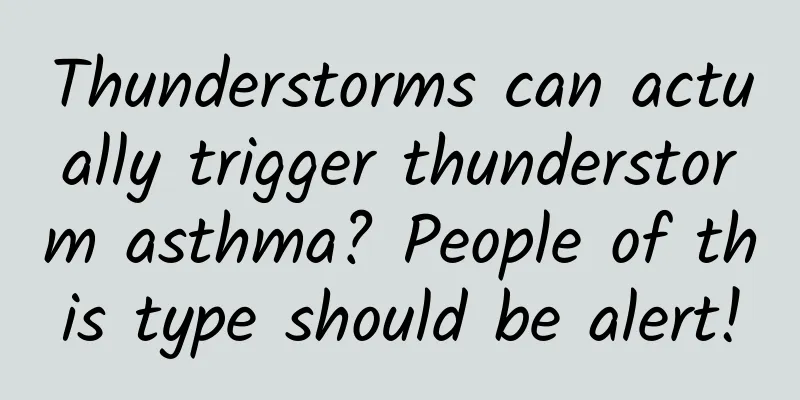Thunderstorms can actually trigger thunderstorm asthma? People of this type should be alert!

|
Review expert: Wang Xuejiang, professor of pathophysiology and doctoral supervisor at Capital Medical University. On September 19, Lanzhou was hit by a sudden rainstorm. After the rain, hospitals were suddenly surrounded by patients with chest tightness, wheezing, and difficulty breathing. The culprit is actually "thunderstorm asthma". This particular disease often occurs from July to September and only appears in local areas with relatively high concentrations of allergic pollen, such as Inner Mongolia and Gansu. So why do thunderstorms trigger asthma? What does this have to do with pollen allergies? Once asthma occurs, how should we deal with it? What measures can be taken to prevent it in advance? Copyright images in the gallery. Reprinting and using them may lead to copyright disputes. PART.01 What is thunderstorm asthma? Thunderstorm asthma refers to an acute asthma attack that occurs during or immediately after a thunderstorm. Symptoms range from mild to severe and can be life-threatening in severe cases. Almost all thunderstorm asthma occurs during the peak pollen season. In my country, pollen allergens from July to September are mainly pollen from herbaceous plants such as Artemisia and Chenopodium. The concentration of mold spores in the north reaches its peak in June and July, and the second peak is in August and September. PART.02 How do thunderstorms + pollen trigger asthma? Thunderstorm weather is a severe convective weather accompanied by strong winds, heavy rainfall, temperature drops and changes in air pressure. In the early stages of a thunderstorm, pollen or mold spores on the ground and in the air are swept into the clouds by rising air currents; during the dissipation of a thunderstorm, these fine particles or fragments settle to the ground with rainfall and downdrafts. Driven by strong winds, the concentration of pollen or mold allergens in the air increases rapidly during a thunderstorm. Simply put, the strong wind before the rain brings pollen into the sky, and then the thunderstorm breaks the pollen into pieces, which, with the amplification of the strong electric field generated by the thunderstorm, finally penetrate into the nasal cavity and cause asthma. PART.03 What are the symptoms of thunderstorm asthma? Thunderstorm asthma often occurs in clusters in local areas, and clinical symptoms usually appear about half an hour after the start of a thunderstorm, which is basically the same as common asthma symptoms. Most patients have moderate to severe acute attacks, with the main clinical manifestations being cough, wheezing, and difficulty breathing. In particular, patients with allergic rhinitis, urticaria, or allergic constitutions may have more and more severe symptoms. PART.04 Who is likely to be targeted by thunderstorm asthma? Patients with a previous history of thunderstorm asthma Patients with a history of asthma and allergies to pollen and/or mold Patients with seasonal allergic rhinitis Patients with no previous diagnosis of asthma but with positive allergen tests (especially positive for pollen allergens) and a family history of allergic disease PART.05 How to prevent thunderstorm asthma? Do physical exercise You can do appropriate physical exercise to enhance your physical fitness, maintain personal hygiene and protection, and pay attention to indoor ventilation on sunny days to prevent respiratory infections. Diagnosed with bronchial asthma Children who have been diagnosed with bronchial asthma need to adhere to standardized treatment to keep their asthma under good control. Follow up regularly and monitor lung function. Make sure to carry bronchodilators with you or keep them at home to relieve symptoms when necessary. High-risk groups Children with asthma have obvious pollen and/or mold allergies and are at high risk of allergic rhinitis. They should avoid going out on rainy days. If they must go out, they can wear masks, hats, protective glasses, etc. After returning to the room from outdoors, they should immediately change their coats, wash their faces and hands, and rinse their noses and take a bath if necessary. Try not to go out Keep doors and windows closed during thunderstorms, and try not to go out after a thunderstorm. Learn about relevant prevention and treatment measures Parents of children in high-risk groups should learn about the relevant prevention and treatment measures for asthma, especially the symptoms of acute asthma attacks and how to deal with them before arriving at the hospital. Thunderstorm asthma is a relatively rare phenomenon. Asthma does not occur every time there is a thunderstorm, but people with allergies still need to take precautions and pay attention to get through thunderstorms safely. |
Recommend
Foreign media said that Google will not return to China in the short term: the fundamental problem has not been solved
[[155170]] According to foreign media reports, al...
Baidu bidding promotion, master these 5 points
The competition in the Baidu bidding industry is ...
They have no money and no resources, and they are also chasing hot topics, so why can they create 100,000+?
This is an era of chasing hot spots, and everyone...
All the creative routines for high-click information flow in the 4 major industries are here!
As we all know, due to its own industry attribute...
How much does it cost to customize the Panzhihua Education Mini Program? What is the price quote for customizing Panzhihua Education Mini Program?
There is no doubt that the topic of mini programs...
The 2018 Mercedes-Benz E-Class has been significantly upgraded in terms of technology and is priced at RMB 422,800 to RMB 629,800.
According to the official website of Mercedes-Ben...
CountdownTimer usage and principle analysis
[[436754]] This article is reprinted from the WeC...
Can Sichuan pepper be used to symbolize love? Let’s look at the plants that symbolize love in the Book of Songs
Love is a universal and abstract emotion of human...
Comments on hot events in the automotive industry in 2016
2016 was a year of both good and bad for new ener...
Huawei AppGallery Paid Promotion Operation Guide
Huawei AppGallery Paid Promotion Operation Guide ...
Sitting for a long time is really harmful to your health! A remedy is to sit for only 22 minutes a day
Sitting for a long time has become a normal part ...
Fictiv: 2022 Manufacturing Industry Report
Manufacturing, Evolution After experiencing numer...









